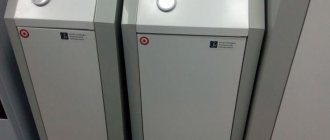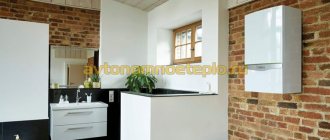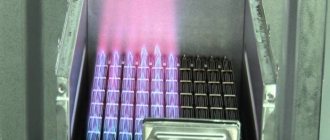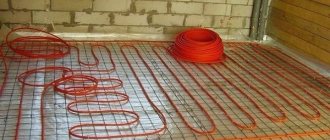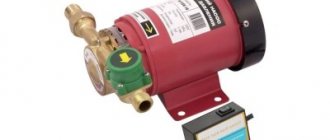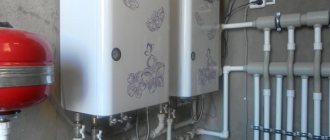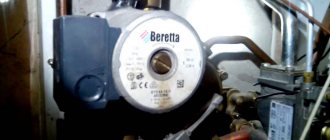Gas boiler for heating a private house
- this is not only a necessity, but one of the main elements of comfortable living, so the choice must be approached consciously at the stage of designing the entire system as a whole. The heating equipment market does not stand still and is constantly evolving, and the result of fierce competition is the availability of the widest selection of boilers of various brands, configurations and modifications. Unlike owners of city apartments, who most often receive a boiler after the fact, the owner of a private house has the opportunity to choose a unit at almost any stage of designing his home.
From the author: the purpose of this article is to become familiar with modern heating technology, its main differences, variety and applicability. We are not representatives of any boiler manufacturer, but are engaged in diagnostics and repair of electronics of gas units and will try to make this review as practical and unbiased as possible.
Criteria for choosing a gas boiler
One of the main criteria for choosing a gas boiler is the required power and the need for hot water at home. Ideally, the required boiler power is selected based on the thermal calculation of the building that will be heated by it. In the process of thermal calculation, the thermal losses of the premises, the number of windows, doorways, ceiling heights, wall materials and the characteristics of the selected thermal insulation are taken into account.
There is an opinion that you can select the power of the unit at the rate of 1 kW per 10 square meters of area, but this value is quite arbitrary. Modern thermal insulation materials, plastic windows and insulated doors significantly increase the energy efficiency class of buildings, and this figure can be reduced by 20-30%.
Significantly overestimating the boiler power can lead to a decrease in its operating efficiency. Modern gas boilers allow you to regulate power in a fairly wide range, but it should be borne in mind that the maximum efficiency and economy of the boiler will be achieved when it operates at rated power. Constant operation of the boiler
the lower power limit reduces the efficiency of the unit by approximately 12-15%. Information on the efficiency value under different operating modes is usually indicated in the passport or instructions for the device. Overestimating the boiler power also risks turning the device on and off too frequently, which negatively affects the actuators and electronics.
When choosing power, some experts recommend taking into account the need to prepare hot water and increasing the power by 20%, or even twice. Naturally, when choosing a gas boiler for heating a private house, it is assumed that the residents will also need hot water, but it would be more correct to be guided not by the power, but by the number of hot water supply points and their distance from the boiler room.
Often the final power and type of boiler are selected based on the needs for hot water preparation.
Depending on this criterion, there may be several options:
- double-circuit gas boiler
- boiler with built-in boiler
- single-circuit boiler and indirect heating boiler
Lemax boilers: features of the line
The domestic company has been operating in the Russian market for several years.
The main activity is the production and sale of heating equipment and water heaters. The line of boilers from the company includes the following items: Lemax gas boilers:
- Premium Series (steel).
- Leader series (cast iron).
- “Prime” series (wall-mounted).
- "Forward" series.
Solid fuel boilers:
The basis of the line of boilers from is made up of fairly inexpensive, economical and reliable gas boilers. They are produced in both single-circuit and double-circuit versions, therefore a boiler from this manufacturer can provide not only heating, but also hot water supply to the dacha.
The power range is also very wide. For most country houses, compact models with a power of about 7.5 kW are suitable. A boiler such as Lemax Premium 7.5N will be quite enough to heat a house with an area of 75 square meters. There are much more productive devices in the line, but they are suitable, rather, not for dachas, but for full-fledged country houses with a total area of 250 square meters or more.
Lemax boilers are produced with two types of heat exchangers - steel and cast iron. The choice here is quite complicated: both options have their own merits, so both the Premium series and the Leader series are in steady demand.
The combined solid fuel boilers of the Lemax Forward line deserve special mention. These devices can operate on brown and hard coal, coke, and also use wood as an additional fuel. The design of the boiler ensures the most complete combustion of fuel - which means that heating efficiency will be higher and fewer combustion products will be formed.
In general, the products deserve positive characteristics. At a relatively low cost, the manufacturer managed to create a reliable and safe boiler, well suited not only for continuous operation, but also for periodic activation in a country house.
Double-circuit gas boiler
Double-circuit gas boilers are designed to heat the coolant in the heating system and, if necessary, prepare hot water, i.e. they implement two independent circuits. Depending on the type of boiler, double-circuit models can have one heat exchanger (primary) and two - an additional plate heat exchanger for preparing hot water. When choosing such a boiler, you should pay attention to the performance of the boiler in DHW mode. On average, the water consumption of one water tap at a comfortable pressure and average pressure will be about 8-10 liters per minute.
Based on this, for example, a 24 kW double-circuit boiler will be able to provide approximately 2 water points, because the performance of the heat exchanger in DHW mode in most cases will be 14-15 liters per minute.
And such productivity will be at a temperature delta of 25 degrees; at a temperature delta of 35 degrees, this value will be significantly less - around 10 liters per minute. Delta means the difference between the cold water temperature and the required heating temperature. A comfortable hot water temperature is about 40 degrees, therefore, at a temperature of incoming cold water of about 5 degrees (in winter), the delta will be exactly 35. As an example, we present these characteristics for some of the most well-known models: Nominal hot water flow rate of popular gas wall-mounted boilers
| Boiler model | Nominal flow delta 30 g, liters per minute |
| Buderus Logamax U072-24K | 11.4 |
| Vaillant VUW 242/5-3 turboTEC pro | 11.5 |
| Protherm Panther 25 KTV | 14 |
| Beretta City 24 CAI | 11.5 |
| Navien ACE-24AN | 11 |
| Baxi ECO FOUR 240i | 11.5 |
With an increase in boiler power, these figures will not increase significantly. For models 32-36 kW this is approximately 15-16 l/min, and for 38-40 kW 18-19 l/min. Therefore, it is obvious that a double-circuit boiler with a secondary heat exchanger can be considered mainly for small private houses or apartments with an area of up to 120 square meters with two, maximum three water collection points. Double-circuit boilers are separate devices and are not intended to work together with boilers.
To summarize, we can highlight the following features of dual-circuit models:
- versatility (heating and hot water at the same time)
- Dimensions (can be mounted in a kitchen cabinet)
- ease of installation and operation
- lower value (cost) of initial costs
Device
The AOGV Siberia gas boiler consists of the following elements:
- Burner. Responsible for igniting and starting combustion of fuel, during which energy is released.
- Heat exchanger. Transfers heat from burned fuel to the coolant to heat a room or water.
- Circulation pump. Distributes the resulting heat throughout the system.
- Pipeline for combustion products.
- Internal sensors for combustion control, temperature, etc.
- External control system. Makes it possible to adjust the basic parameters of the device and the process of its operation.
- Gas filters.
- Additional sensors, installations.
AOGV Siberia operates by burning fuel, which supplies heat to the heat exchanger. This is where the water is heated. Next, the pump supplies hot coolant to the system. It receives data about the required amount of heat and circulation speed through installed sensors.
After heating to the set temperature, AOGV Siberia extinguishes the burner and the standby mode is activated. After the temperature drops to the minimum set value, the boiler automatically turns on and the heating process starts again.
Operating rules:
- If the burner malfunctions, do not turn on the boiler;
- do not use the device in a heavily polluted chimney;
- water should be heated to 90 °C;
- install equipment in compliance with safety regulations;
- Before turning on, check the tightness of the connections of the parts;
- carry out maintenance annually.
The boilers work with all types of water supply. They have a built-in layer of thermal insulation that prevents the outer shell from heating up, which helps avoid burns and injuries during operation.
Boiler with built-in small volume boiler
Such boilers have some advantages over typical double-circuit ones: instead of a flow-through heat exchanger, a small-capacity boiler is installed (usually 40-60 liters) and this means that there is always a small supply of hot water. Firstly, residents practically do not have to wait for the water to heat up for the first time. Secondly, the boiler will turn on less often - it happens that you need to briefly open the tap to rinse the cup. In this case, the double-circuit boiler will turn on and heat the water at full power; the option with a built-in boiler will turn on only when the temperature of the reserve water drops below the set one. Fewer switches mean longer service life of actuators.
For example: the Ariston CLAS B EVO 24 FF model (built-in tank of 40 liters) already has a performance in DHW mode of 16 liters per minute at a delta of 35 degrees and 19 liters per minute at a delta of 30 degrees 10 minutes after switching on!
Obviously, such boilers have a greater degree of comfort, but are significantly more expensive. Also, they do not have problems with scale formation, that is, they are less demanding on water quality. When choosing a boiler for a private home, you should pay attention to performance in DHW mode and ease of maintenance.
Factors for choosing a gas convector
- power. This is one of the most important parameters on which the choice of unit is based. Because it determines both the heating level and gas consumption. In turn, power is determined by the volume of the room. It has been experimentally established that the optimal power is 1 kW per 30 cubic meters. space subject to standard insulation.
Note that different manufacturers are developing certain market segments, offering customers convectors of different power:
| Manufacturer | Country of manufacture | Power range, kW |
| Alpine Air | Italy | 2,3-9,46 |
| Hosseven | Türkiye | 2,7-10 |
| ACOG | Ukraine | 2,3-6 |
| Emax | Hungary | 2,5-5,8 |
| FEG | Hungary | 3-7 |
| Karma | Czech | 2-4,7 |
| Cordy | Ukraine | 2,3-5,2 |
| FERRAD (Adarad) This brand has replaced | Türkiye | 2,2-4,9 |
Material prepared for the website www.moydomik.net
- method of gas supply - from the main line or from a cylinder;
- Efficiency The efficiency of the most modern convector models reaches 97%, but on average ranges from 80 to 97%;
- heating efficiency. Compared to traditional heating, the cost of using a gas convector is reduced by 500%;
- the extremely low temperature at which the unit can operate. Relevant for northern regions. The gas convector can operate at air temperatures down to -50°C;
- life time. Most manufacturers declare that the unit will operate for 20 years;
- price. In absolute terms (acquisition costs), a gas convector is more expensive than an electric one. But due to operating costs, gas is cheaper. The estimated payback period is 2 heating seasons (depending on the area).
Just purchasing a gas convector that meets all the requirements imposed by the premises and the user is not the key to its successful operation. Maximum efficiency is possible only with proper transportation and installation.
Source: moydomik.net/kommunik/otoplenie/433-gazovye-konvektory-otopleniya.html
Single-circuit boiler and indirect heating boiler
An indirect heating boiler is a container for storing water that does not have its own heating element, and heating occurs from external sources (for example, a boiler or solar panels). According to many experts, the use of a single-circuit boiler and boiler in a heating scheme is most preferable. This scheme differs from the previous version in the volume of the boiler itself in the direction of increase. The boiler is selected based on the hot water needs of the residents of a private house. There are various methods for choosing, calculators - this is the topic of a separate review. Individually, it is necessary to determine the maximum possible one-time water consumption, for example, in the morning, and select a container of the required volume. The performance of the boiler will depend on the power of the boiler, because the power of the boiler itself is limited by the power of its coil. The boiler volume is selected based on peak water consumption values. If we average, we can give the following recommendations: up to 80 liters for a family of 1-2 people, up to 150 liters for a family of 3-4 people and from 200 liters for families of more than 5 people. In non-standard cases, it is necessary to carry out design calculations.
Thus, we get the following advantages of using a boiler:
- constant supply of hot water (maximum comfort)
- lower hydraulic resistance compared to a plate heat exchanger
- reducing the number of boiler starts
- reducing water consumption (no need to drain water while waiting for heating)
- no scale formation (does not interfere with regular maintenance)
Some heating equipment manufacturers have ready-made boiler + boiler options that are installed into a single system.
So, in the end, we select the boiler according to the heat losses of the house, the boiler according to the needs for the amount of hot water.
Installation of a gas heating system
The main element of a gas heating system is a heating boiler, which provides heating and maintaining the temperature of the coolant in the network. Also, heating efficiency depends on correctly selected heating radiators, the material from which they are made and the area of the heated surface. Our specialists will perform calculations to select a reliable boiler and radiators for any facility.
The list of installation services includes:
- Preparing the object for installation - drilling holes in the walls;
- Laying pipes for coolant supply;
- Laying hot water supply pipes, from which plumbing will be supplied if a double-circuit boiler is installed;
- Installation of heating radiators in rooms;
- Installation of a gas boiler;
- Installation of a combustion products removal system;
- Connecting elements into a single heating system.
Installation time depends on the area of the facility, complexity and branching of the network. Our craftsmen will complete the work as quickly and efficiently as possible.
Types of gas boilers
In addition to the main operational characteristics, boilers have a number of other differences: material of manufacture and type of heat exchanger, type of combustion chamber, installation method.
Based on the installation method, there are floor-standing and wall-mounted boilers. Wall-mounted boilers are compact in size, light in weight and versatile; they are used when there is no separate room for installing a gas boiler. Floor-standing models are equipped with heat exchangers made of cast iron (therefore, they are heavy) and require certain requirements from the room during installation. A distinctive feature of such boilers is their high reliability. The cast iron heat exchanger is highly resistant to corrosion and has a long service life. The disadvantages are fragility and heavy weight.
Heat exchangers of wall-mounted boilers can be made of steel, copper, aluminum alloy or stainless steel. Steel heat exchangers are the cheapest and have a number of disadvantages, such as lower efficiency, a tendency to deformation and have a shorter service life. Copper heat exchangers have significantly greater thermal conductivity, corrosion resistance and lighter weight.
Bithermic heat exchanger
It is worth considering separately the design feature of gas boilers with a bithermic heat exchanger. In “bithermics”, heating of the heating fluid and running water occurs in a single primary bithermic heat exchanger (there is no secondary one). When the boiler needs to heat the heating system, the circulation pump is turned on, when heating of the hot water supply is required, the pump is turned off and all the power is transferred to the tap water flowing there. The heat exchanger itself is a pipe-in-pipe structure (one is heating, the other is DHW). The advantage is the low price, but water treatment of the water passing through the heat exchanger becomes an important necessity. Limescale, which actively forms on the walls at high operating temperatures, can significantly reduce the service life.
Atmospheric and turbocharged gas boilers
According to the method of removing combustion products, gas boilers are divided into atmospheric, where smoke is removed from the combustion chamber due to natural draft in the chimney, and turbocharged, in which combustion products are removed forcibly using a fan.
Gas boilers with a fan are more expensive, but more economical and have greater efficiency. To install such a boiler, a classic chimney is not required; the use of a coaxial chimney (pipe in pipe) is sufficient, in which air is supplied and discharged through one common pipe, which can be removed from the room through the wall.
Modern fans with adjustable speed allow you to achieve significant savings and, in combination with a modulating gas burner, regulate the boiler power over a very wide range, as well as obtain high efficiency in low power modes.
Condensing boilers
Everyone roughly represents the process of heat transfer in a conventional gas boiler: the heat exchanger is located directly above the burner and when the gas is burned, heat is transferred to the coolant. During combustion of the gas-air mixture, carbon dioxide, water and heat are generated. The remaining heat that the heat exchanger did not have time to accept goes into the chimney, while the temperature of the flue gases can range from 140 to 170 degrees.
With this scheme, a large amount of heat simply flies out into the chimney. This is due to the fact that combustion products contain approximately 10% water in a gaseous state, i.e. in the form of steam and manufacturers are trying in every possible way to avoid condensation of this steam inside the boiler or chimney. The design of a traditional boiler is designed to prevent the formation of condensation, because condensate is water only in a simplified form. In reality, combustion products contain harmful impurities that form an aggressive mixture of acids (nitric, sulfuric, coal), which lead to rapid wear of boiler elements.
The process of condensation formation begins when the combustion products are cooled to approximately 55-57 degrees. Therefore, the solution to extract additional heat is to cool the combustion products to the point where condensation forms inside the boiler and control this process. For maximum heat transfer to the coolant, a large area of the heat exchanger and the creation of conditions for the formation of condensation inside this heat exchanger are required. In addition, the condensate, when cooling, gives additional heat, which, in fact, is transferred to the coolant, flowing down the walls. That is why marketers often indicate the efficiency of such boilers as more than 100%, adding the effect of heat transfer by condensate to the efficiency of a traditional boiler.
Example: Baxi LUNA DUO-TEC 1.24 GA. The maximum power is 24.7 kW, and the minimum power is only 3.7 kW!!!
In addition to efficient heat removal, condensing boilers can regulate power over a very wide range. This is especially true in the middle zone, where the average annual temperature ranges from 0 to 5 degrees. Therefore, such a boiler will be much more economical than a traditional one in the off-season, when the use of the rated power of the boiler is not required.
In addition to all the advantages, it is worth noting that to obtain the maximum capabilities of a condensing boiler, a low-temperature operating mode is required (supply temperature less than 50 degrees), and this is not always possible. Since the boiler, in fact, is additionally a generator of condensate, it must be disposed of in a country house using septic tanks - this will have to be taken care of additionally.
In a country house, insects can also become a real problem for such a boiler. The temperature of the exhaust gases is low and therefore attracts insects, and in the case of a coaxial chimney, x will be continuously sucked into the combustion chamber.
Classification of gas convectors
At installation location:
- wall-mounted The wall-mounted gas convector is compact, does not occupy floor space, and does not create restrictions for the placement of interior elements. Installing equipment above the window allows you to get the effect of a thermal curtain, when the air entering through the window will warm up as it enters the room. Wall-mounted convectors are characterized by low power (up to 10 kW), however, they are more popular;
- floor The floor-mounted gas convector is more powerful and is designed for heating large rooms. The power of a floor convector can reach 100 kW, which affects the weight and dimensions of the unit.
- built-in convectors. But they belong to the “water convector” group.
By gas supply source:
- pipeline (natural gas). All convectors are initially designed for connection to a gas pipeline;
- liquefied gas (propane-butane from a cylinder). The transition to this type of gas supply is possible thanks to the installation of a transition kit. But, it should be taken into account that the heating costs will be the same as with heating using the traditional method, and the requirements for the heating device from the cylinder are much stricter.
The method of gas supply determines the mobility of the convector and the cost of heating.
According to the method of combustion organization:
- closed chamber (for example, gas convector Alpine Air NGS 50). Here, the air supply and exhaust are organized through a horizontal telescopic pipe, which allows one to avoid the arrangement of a traditional chimney, replacing it with a coaxial chimney (pipe within a pipe). This principle allows exhaust gases to be removed through the inner pipe and air supplied through the outer one.
- open chamber (for example, gas convector Hosseven HP-8 or Alpine Air M-145). In this case, the organization of a chimney is required. The heating device, according to the principle of operation, is similar to a fireplace, and users can watch the play of live fire.
According to the material used to manufacture the heat exchanger:
- cast iron. Withstands higher temperatures;
- steel. Used in units in the lower price range.
Note that the material from which the heat exchanger is made determines the duration of operation of the convector.
According to the degree of energy dependence:
- independent. They do not need to be connected to an electrical outlet to operate. In demand in regions with power outages;
- dependent. Electricity is used to ignite the main burner. This technique has a positive effect on gas consumption, reducing it by a quarter compared to independent models.
By additional functions
These are:
- fan. Allows you to increase the speed of air passage through the heat exchanger. On the one hand, this reduces the time for warming up the room, on the other hand, it cools the heat exchanger itself, preventing its failure;
- timer. Allows you to automate the switching on and off of the unit.
On gas: design features
The functionality of double-circuit boilers is determined by the features of their design. They are equipped with two heat exchange circuits, one of which heats a closed heating system, the second - water for household needs.
The coolant in the primary circuit is heated in the gas combustion chamber. The water for the DHW system is heated by the hot coolant from the primary circuit only when you open the tap with warm water. In this case, the valve built into the boiler shuts off the supply of coolant to the heating system.
The longer the hot water tap is open, the more the heating system cools down. Therefore, if the need for hot water is high, purchasing a double-circuit boiler is not advisable; in this case, it is better to choose a single-circuit boiler, and an indirect heating boiler for it.
Heat exchanger characteristics
In modern double-circuit boilers, two types of boilers are mainly used - bithermic and flow-through. The first one is more used when domestic hot water consumption is low. Flow-through heaters have a developed heating surface, which ensures high water heating speed and large volumes.
Models with bithermic heat exchanger
Heating of the coolant in a gas boiler equipped with a bithermic heat exchanger occurs due to the circulation of the coolant through copper channels, the sections of which are made with a complex configuration inside the housing.
The heating coolant circulates through the external channels, and heated water for hot water is inside the tubes. The heat exchanger receives heat from the operating gas burner device.
Operating principle of a bithermic heat exchanger:
- In heating mode, at a low coolant temperature in the circuit, an electromechanical gas flow valve supplies gas to the nozzle, which is ignited by a piezo igniter.
- The fuel burns, and the released heat is transferred through the walls of the heat exchanger to the coolant.
- When the set water temperature is reached, the gas supply to the double-circuit gas boiler stops and turns on automatically when it decreases.
- When the user opens the hot water tap on the mixer, tap water will begin to flow into the DHW heating circuit of the bithermal heater. The coolant enters the small hot water circulation circuit and quickly heats the cold water.
- After the DHW tap is closed, the valve redirects the coolant to the heating circuit.
Models with flow-through heater
The principle of operation of boilers operating on gas fuel, in the design of which a separate flow-through heat exchanger for domestic hot water is installed, is that the coolant for heating and hot water is heated in separate housings.
In a flow-through DHW heat exchanger, tap water is heated by a heating fluid, which is switched by a three-way valve.
At this moment, the water in the heating circuit of the in-house heating system continues to circulate through a separate heat exchanger, naturally, without receiving heat. In order for the system to operate reliably, an electric circulation pump and two separate expansion tanks for each circuit are integrated into it.
This scheme is more efficient in terms of specific fuel indicators, can provide a larger load for domestic hot water, and is not so sensitive to the quality of the source water. In addition, the heating surfaces of the heat exchangers are designed in such a way as to ensure maximum heat removal from the combustion chamber.
For example, in a hot water supply circuit, the flows of coolant and cold water are directed according to the countercurrent principle, which allows for maximum temperature reduction in the heating circuit and reduces the processes of scale formation on the internal heating surfaces of the heat exchanger.
Selection by types and parameters
Double-circuit gas boilers are presented on the market with a huge variety of models, and it is sometimes difficult to understand which one is best to choose. Therefore, to make the right choice, you must clearly understand the characteristics you need.
These include:
- power, that is, the ability to effectively heat the required area and heat a sufficient amount of water;
- boiler installation method - mounted (wall-mounted) or floor-mounted;
- type of combustion chamber, it can be open or closed;
- operating principle - convection, which requires the installation of a full-fledged chimney, or condensation, which allows the use of a coaxial chimney;
- degree of automation, type of ignition and availability of protective functions;
- the manufacturer and the degree of trust in him.
Parameters such as power and operating principle depend on the thermal characteristics of the building and its area. Otherwise, the buyer’s choice is usually determined by his stylistic preferences and taste, needs and the price of the equipment.
Power
This parameter determines whether the boiler is truly capable of heating the house for a long time, efficiently and without overload . A complete thermal engineering calculation, performed by service specialists, must take into account all the features of the structure:
- wall material and degree of thermal insulation;
- number and total area of windows;
- ceiling height;
- the presence of complex elements - bay windows, glazed heated terraces, greenhouses.
It is quite difficult to perform such a calculation on your own, so a simpler method is usually used. It is enough to calculate the total area of heated premises, and then apply the formula:
P = S 100 / 1000.
where P is the required power, kW;
S is the area in meters.
For a detached house with insufficient insulation, this figure is increased by 15% in temperate latitudes and by 30% in northern regions.
So, for an apartment with an area of 120 square meters, the nominal boiler power is 12 kW, but for a private house built in the Moscow region, it is better to choose a power of at least 15 kW, and for a colder region - 20 kW. This will allow the boiler to operate without overload.
You should also pay attention to the performance of the DHW circuit. To calculate hot water consumption, you need to know the number of water points in a private house and the probability of their simultaneous operation. In this case, a flow rate of 400 liters per hour (6.6 liters per minute) is assumed for each point. If two or more points are turned on simultaneously, this indicator must be increased by the calculated number of times.
The total boiler power, sufficient to heat a private house and provide it with hot water, consists of the power of the heating system and the power of the heat exchanger for hot water supply.
Wall or floor?
The method of installing the boiler depends on its power : models designed to heat a private house with an area of up to 200-250 square meters are usually produced in a wall-mounted version. They are compact and do not exceed the size of a regular water heater; they can be placed in any convenient place, for example, in the kitchen or bathroom.
Such boilers are designed for a hot water output of no more than 14 liters per minute and can simultaneously provide two water points. To reduce losses, it is recommended to install them close to hot water consumers.
Boilers with a total power of more than 20 kW are usually floor-standing. Their size and weight are superior to wall-mounted models, and it is better to place them in a boiler room with an equipped supply and exhaust ventilation system. The requirements for a particular model depend not only on the size, but also on the operating principle and type of combustion chamber.
Combustion chamber - which is better?
Gas boilers can be equipped with an open or closed combustion chamber. They differ in the way air is supplied to the combustion zone. In an open chamber, air leaks from the volume of the room in which the boiler is installed.
Therefore, they can only be installed in a boiler room equipped with a window or forced ventilation, otherwise the air in the room will become unsuitable for breathing. In addition, to ensure stable draft and complete removal of flue gases, such a boiler requires a full-fledged chimney with a vertical height no less than that specified in the passport.
The closed combustion chamber allows you to install the boiler in any room of the house. To supply air and remove exhaust gases, in this case a coaxial chimney is used, consisting of two corrosion-resistant pipes located one inside the other. Flue gases exit through the inner pipe, and fresh air taken from the street enters through the space between the pipes.
In this case, fresh air is recovered (heated), which has a positive effect on the combustion process. A coaxial chimney can be routed horizontally through the wall. In this case, the draft is provided by a built-in fan. Wall-mounted models usually have a closed combustion chamber, so they can be used not only for heating a house, but also in apartments.
Principle of operation
According to the principle of heat removal, gas boilers can be convection and condensation. The difference is that in a convection heat transfer fluid is heated in the combustion chamber, while in a condensation heat transfer the heat obtained from steam condensation is additionally used.
The advantage of a condensing boiler is its high efficiency - up to 96%. But its disadvantage is the strict requirements for the design of the heating system : the temperature of the return water entering the heat exchanger must not exceed certain values, usually 60ºC, which requires professional calculation and configuration of the system and large, expensive radiators.
The implementation of the convection heating principle is possible in boilers with any combustion chamber. Condensing boilers always have a closed combustion chamber.
Energy dependence, degree of automation and type of ignition
The simplest models of gas boilers do not require connection to an electrical network. Their functionality, as a rule, is low - they have an open combustion chamber, require connection to a vertical full-fledged chimney, and they can only be started manually.
Modern models of gas boilers are connected to the electrical network; they are equipped with automation, which allows them to operate completely autonomously, without human intervention.
Two parameters important for ease of use:
- number of heating stages;
- ignition type.
Heating stages are modes in which the boiler can operate to provide the specified heating parameters.
The cheapest models are single-stage. In them, the heating process alternates with a standby mode. Upon reaching the set temperature, the boiler stops burning; heating will begin again only after the coolant has cooled to the lower permissible value. This may result in uneven heating.
With two- and three-stage heating, the boiler automatically selects the combustion intensity depending on the set temperature, so the coolant does not overheat and the room temperature remains stable. The price for such models is slightly higher.
The type of ignition in gas boilers can be manual - using a piezoelectric element, or electronic - in models equipped with a control unit. After shutdown, piezo ignition requires manual start; electronic ignition turns on itself after a break in the power supply or elimination of emergency operation of the boiler.
Other convenient features built into the gas boiler help make its operation completely safe. Almost all modern boiler models are equipped with them. Such functions include control of flame, draft, gas flow and other combustion modes and heating system.
Errors in the operation of the boiler can be found out by codes that are reflected on the electronic control unit display; some models also allow you to connect a GSM alert system via SMS.
Famous brands and manufacturers
Focusing only on the equipment manufacturer is not entirely correct, since most companies have a wide range of models with a variety of functions. But purchasing gas equipment from an unknown manufacturer, even with high-quality assembly, carries a number of risks. Therefore, when choosing a manufacturer, you should pay attention to the following nuances:
- warranty period and period of use of the equipment;
- location of service centers where repairs or maintenance can be performed;
- the ability to buy or order spare parts and consumables;
- user reviews about a particular manufacturer and model
There are special services on the Internet that make up a popular rating, which you can always contact before purchasing any equipment.
Price is not always an indicator of quality. Well-known, well-promoted brands can cost significantly more than their more modest counterparts, but the functions provided will be the same.
A representative of decent German quality VUW line of double-circuit boilers , represented by models with an Atmotec open combustion chamber and a Turbotec closed combustion chamber. The average price of the first is 50 thousand rubles , the second - 60 thousand rubles .
These are energy-dependent boilers with electronic ignition and control, using step-by-step power control. The boilers are equipped with convenient and intuitive controls and an LCD display, have many protective functions and a self-testing system.
Other German companies representing gas equipment on the Russian market are Viessmann and Bosch . The difference between Viessmann boilers is the possibility of remote control from a PDA, while Bosch boilers can operate on liquefied gas, which is convenient for the Russian outback, where gas connection is still expected. Depending on the model and additional functions, their price ranges from 30 to 300 thousand rubles.
Gas boilers "Ciao-Nord" from Beretta, Italy, have a closed combustion chamber, compact dimensions and convenient control. Their high efficiency allows them to be used in northern regions: they are equipped with an improved heat exchanger and a three-speed pump that regulates the speed of coolant movement through the system. You can buy them starting from 40 thousand rubles .
Another representative of Italian boilers is the Ferroli company with a new development, a bimetallic heat exchanger. Electronic control and self-diagnosis, as well as many useful functions, allow you to purchase a reliable gas unit for reasonable money - from 25 thousand rubles.
Representatives of the Czech company Protherm gas double-circuit boilers “Tiger” and “Panther” in a moisture-proof casing allow installation in rooms with high humidity. The “Tiger” modification has a modern design and an electronic control panel; its price ranges around 55-60 thousand rubles. “Panther” is equipped with simple push-button controls and has a more attractive price - about 40 thousand rubles.
Having decided on the necessary characteristics of a gas boiler, you can choose the most suitable option that will make the heating process, as well as heating water for domestic needs, uninterrupted.
In this case, you must follow the installation rules and follow the recommendations of the attached instructions regarding the installation of the heating system and chimney. Only in this case can you be sure of the safe operation and reliability of the model that suits you.
gidpopechkam.ru
The most important parameters and characteristics
Gas heating boilers for apartments can be classified according to several criteria.
One and two contour models
• single-circuit – they only heat the living space;
• double-circuit – in addition to heating, they heat water used in everyday life.
Double-circuit boilers, in turn, are divided into:
• boilers with a boiler;
• boilers using a flow-through method to heat water.
Natural or forced draft
• turbo – with forced draft. Air is sucked into the boiler through a coaxial pipe and removed through it;
• conventional heating boilers – with natural draft. Combustion air is taken from the room. Flue gases are removed through a conventional chimney.
To heat an apartment, boilers with a closed combustion chamber are often used if the house does not have a central chimney.
How to calculate the required power
Approximately, an average ratio is used: 1 kW of power is needed to heat 10 m2 of an insulated room with ceilings up to 3 m high. More accurate energy costs can only be determined by taking into account the individual characteristics of the room.
How to choose the right boiler for your apartment
1. First of all, you need to decide whether you need a single- or double-circuit boiler for your apartment.
2. Next, you need to determine the required boiler power for apartment heating.
3. The next point is to determine the required boiler performance for hot water supply. In the boiler characteristics, this value is indicated in l/min, i.e. how many liters of hot water will pour out of the tap in one minute. The optimal indicator for one hot water supply point in an apartment is 6.6 l/min.
4. After this, you need to decide on less significant characteristics - openness/closedness of the combustion chamber, boiler design, etc.
Before installation work, I advise you to read the article - installing a heating boiler. Average prices for installation are also given there.
The most popular boiler manufacturers, whose products are in greatest demand, are Baxi Main, Vaillant Turbotec, Nevalux boilers. These boilers have compact dimensions and can easily fit into the interior of your apartment. On our website you can read reviews about BAXI boilers.
teplostroyka.ru
